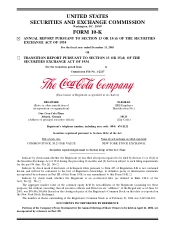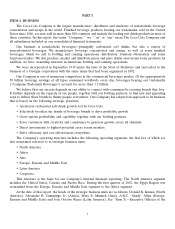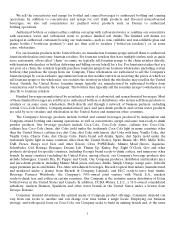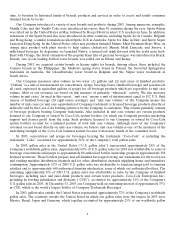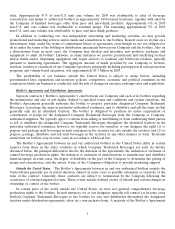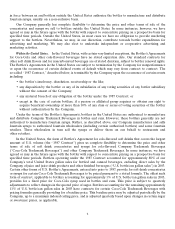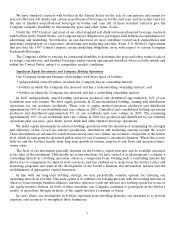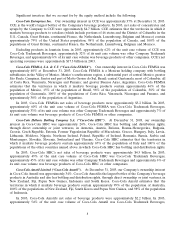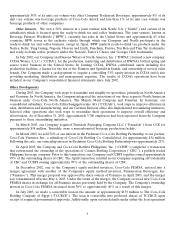Coca Cola 2003 Annual Report Download - page 10
Download and view the complete annual report
Please find page 10 of the 2003 Coca Cola annual report below. You can navigate through the pages in the report by either clicking on the pages listed below, or by using the keyword search tool below to find specific information within the annual report.
We have standard contracts with bottlers in the United States for the sale of concentrates and syrups for
non-cola-flavored soft drinks and certain noncarbonated beverages in bottles and cans; and in certain cases for
the sale of finished noncarbonated beverages in bottles and cans. All of these standard contracts give the
Company complete flexibility to determine the price and other terms of sale.
Under the 1987 Contract and most of our other standard soft drink and noncarbonated beverage contracts
with bottlers in the United States, our Company has no obligation to participate with bottlers in expenditures for
advertising and marketing. Nevertheless, in our discretion we may contribute toward such expenditures and
undertake independent or cooperative advertising and marketing activities. Some U.S. Bottler’s Agreements
that pre-date the 1987 Contract impose certain marketing obligations on us with respect to certain Company
Trademark Beverages.
The Company’s ability to exercise its contractual flexibility to determine the price and other terms of sale of
its syrups, concentrates, and finished beverages under various agreements described above is, both outside and
within the United States, subject to competitive market conditions.
Significant Equity Investments and Company Bottling Operations
Our Company maintains business relationships with three types of bottlers:
• independently owned bottlers, in which the Company has no ownership interest;
• bottlers in which the Company has invested and has a noncontrolling ownership interest; and
• bottlers in which the Company has invested and has a controlling ownership interest.
In 2003, independently owned bottling operations produced and distributed approximately 24% of our
worldwide unit case volume. We have equity positions in 52 unconsolidated bottling, canning and distribution
operations for our products worldwide. These cost or equity method investees produced and distributed
approximately 58% of our worldwide unit case volume in 2003. Controlled and consolidated bottling operations
produced and distributed approximately 8% of our worldwide unit case volume in 2003. The remaining
approximately 10% of our worldwide unit case volume in 2003 was produced and distributed by our fountain
operations plus our juice, juice drink, sports drink and other finished beverage operations.
We make equity investments in selected bottling operations with the intention of maximizing the strength
and efficiency of the Coca-Cola system’s production, distribution and marketing systems around the world.
These investments are intended to result in increases in unit case volume, net revenues, and profits at the bottler
level, which in turn generate increased gallon sales for our Company’s concentrate business. When this occurs,
both we and the bottlers benefit from long-term growth in volume, improved cash flows and increased share-
owner value.
The level of our investment generally depends on the bottler’s capital structure and its available resources
at the time of the investment. Historically, in certain situations, we have viewed it as advantageous to acquire a
controlling interest in a bottling operation, often on a temporary basis. Owning such a controlling interest has
allowed us to compensate for limited local resources and has enabled us to help focus the bottler’s sales and
marketing programs and assist in the development of the bottler’s business and information systems and the
establishment of appropriate capital structures.
In line with our long-term bottling strategy, we may periodically consider options for reducing our
ownership interest in a bottler. One such option is to combine our bottling interests with the bottling interests of
others to form strategic business alliances. Another option is to sell our interest in a bottling operation to one of
our equity investee bottlers. In both of these situations, our Company continues to participate in the bottler’s
results of operations through its share of the equity investee’s earnings or losses.
In cases where our investments in bottlers represent noncontrolling interests, our intention is to provide
expertise and resources to strengthen those businesses.
7

